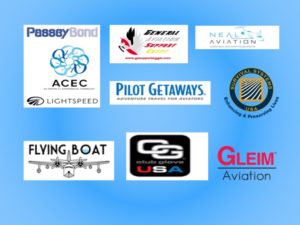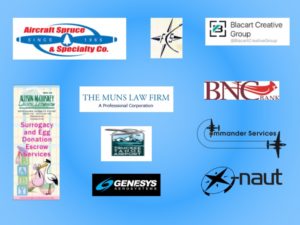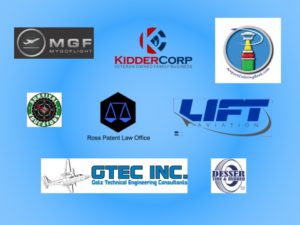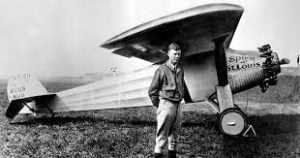Our clients are incredibly inspiring! In several upcoming episodes, expect to hear interviews with some of the folks we are lucky enough to work with!
We interviewed Robert DeLaurentis, author and pilot, to talk about many things, including marketing.
Robert was the pilot of a record-breaking circumnavigation of the globe with visits to 43 countries in the Spirit of San Diego. He has done more than 100 TV, radio, newspaper and magazine interviews, he’s an internationally featured speaker for EAA and AOPA, and the future pilot of a pole-to-pole flight around the world in a modified Turbo Commander named the Citizen of the World this June.
Obviously big projects with many, many partners and sponsors.
In this episode, John and I talk with Robert about how he makes these huge projects successful, and we share our three biggest marketing takeaways.
[smart_track_player url=”http://traffic.libsyn.com/aviationmarketing/AMHF_0159_-_Thinking_Big_with_Robert_DeLaurentis.mp3″ background=”default” social_linkedin=”true” ]
1) Think Big.
Or as Robert DeLaurentis would say, “dream impossibly big.”
Big dreams and big plans have a “cool factor” that attract sponsors, partners, team members and ultimately customers.
2) Build on Previous Successes.
Every mission, every book, and every product or undertaking Robert touches benefits from his previous successes. Investors love a success story.
Many people and companies make the mistake of starting from scratch with every new product or new project. It’s much easier and more inspiring to build on your past successes.
3) Get Help!
No one accomplishes a massive project alone. Robert has a team of aviation experts, logistics experts, weather experts, and yes, branding experts and marketing experts working with him to accomplish his goals.
Transcript:
Paula Williams: Robert we’re really excited to have you, I know you’re in the final stretch of preparations for your flight, and so we’re really glad that you could spend some time with us this morning.
Robert DeLaurentis: I’m happy to talk with you, you know the more people I can share my story with the better.
Paula Williams: Fantastic.
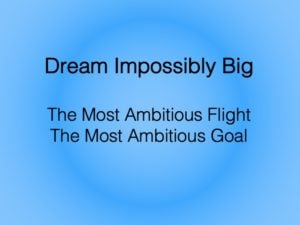 Robert DeLaurentis: We’re trying to reach outside of general aviation and capture interest from the rest of the world. And on our first flight, around the equator back in 2015, it was very much aviation safety and technology, but because this flight connects the South Pole to the North Pole and everybody in between, we want to get people outside of aviation excited about aviation. I think that’s how we’ll grow it. A lot of general aviation is focused on high school kids, which is great, but beyond that there’s the young kids that need to be inspired, then everybody out there who ever dreamed of flying is also another potential, so. We’re trying to hit all our different markets.
Robert DeLaurentis: We’re trying to reach outside of general aviation and capture interest from the rest of the world. And on our first flight, around the equator back in 2015, it was very much aviation safety and technology, but because this flight connects the South Pole to the North Pole and everybody in between, we want to get people outside of aviation excited about aviation. I think that’s how we’ll grow it. A lot of general aviation is focused on high school kids, which is great, but beyond that there’s the young kids that need to be inspired, then everybody out there who ever dreamed of flying is also another potential, so. We’re trying to hit all our different markets.
Paula Williams: Right, and I know everybody in the industry is concerned about getting kids interested in aviation and in the sciences of things just because we can see the math, you know we’re gonna need more of everything right.
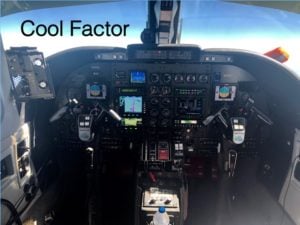 Robert DeLaurentis: Yeah, and you know the trip, even though it’s only about three and a half months, what I call the pay dirt, especially for sponsors, is the two years after the trip, because we’ll be taking this plane, that’s set records, speed and distance records over the poles, and carried a NASA experiment and been tracked for the first time ever using the 66 new Aireon satellites globally and over the poles, around to different aviation groups, hopefully EAA Young Eagle groups, and letting them get on a Gleim simulator, and experience some of the things I might experience over the poles. Hopefully not, but fuel gelling at -67 celsius, a loss of navigation, pilot fatigue, some of the worst weather in the world, and sure some other surprises.
Robert DeLaurentis: Yeah, and you know the trip, even though it’s only about three and a half months, what I call the pay dirt, especially for sponsors, is the two years after the trip, because we’ll be taking this plane, that’s set records, speed and distance records over the poles, and carried a NASA experiment and been tracked for the first time ever using the 66 new Aireon satellites globally and over the poles, around to different aviation groups, hopefully EAA Young Eagle groups, and letting them get on a Gleim simulator, and experience some of the things I might experience over the poles. Hopefully not, but fuel gelling at -67 celsius, a loss of navigation, pilot fatigue, some of the worst weather in the world, and sure some other surprises.
Paula Williams: Right.
Robert DeLaurentis: But experience it on the simulators, and then literally go into the plane, which is gonna be the best video game on the planet, with all the latest avionics, and see it, touch it, smell it, experience it. And we’re hoping that they’ll take pictures next to those giant, five-bladed ten-foot props with a LIFT Aviation, aviation helmet on.
Paula Williams: Right. Let’s-
Robert DeLaurentis: That’ll be a memorable picture to post on their social media for sure. And-
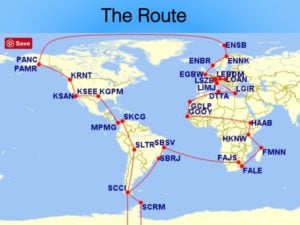 Paula Williams: Absolutely. So let’s back up really fast, for people who aren’t familiar with your flight, and maybe you can give us the 10 000 foot view or the 30 000 foot view of what this is, what you’re doing, and why you’re doing it.
Paula Williams: Absolutely. So let’s back up really fast, for people who aren’t familiar with your flight, and maybe you can give us the 10 000 foot view or the 30 000 foot view of what this is, what you’re doing, and why you’re doing it.
Robert DeLaurentis: Yeah, 35 000 feet is hopefully where I’ll be flying most of this. So the flight currently departs January 12th, from San Diego’s Gillespie Field. It’s supposed to be three and a half months but we’re not in a hurry to get it done, because we’re going for maximum visibility for the aviation community, and to support our world peace cause. And I’ll stop in approximately 26 countries, hopefully lecturing for some of the UN Association offices, and at different Explorer Clubs, and if there’s a big enough crowd I’d like to throw in some more presentations so we can get the word out. But the goal is to connect the South Pole to the North Pole and everybody in between on a mission of global peace. And at a time when the world is divided or, no pun intended, polarized, we want to connect the poles. And the plane is a global billboard for our causes.
Robert DeLaurentis: One of the things we wanna highlight are the oceans, because they’re 70% of the planet, and I’ll be flying along the Southern Pacific, Southern Atlantic, and the North Atlantic oceans. So there’s that. We’re also highlights the Nicklas Foundation, which is an organ transplant foundation, and their founder, Rodney DeBaun’s going to be flying with me on the first leg. And we’ve produced a second coloring book that you haven’t seen yet but you will soon, on their organization and it ties in nicely with the flight.
Robert DeLaurentis: So besides the NASA experiment that we’re carrying, which is a wafercraft spaceship, we’re gonna highlight some aviation safety and technology, and set some speed and distance records over the poles.
Paula Williams: Fantastic.
Robert DeLaurentis: That’s a mouthful.
Paula Williams: It is. And something that big, you’re working with an awful lot of organizations and things like that, that’s an amazing undertaking.
Robert DeLaurentis: Yeah we have about 80 sponsors now, you guys are of course one of them. And-
Paula Williams: Proudly so.
Robert DeLaurentis: … trip like this is not possible as one person. It takes a village. And we have some of the most amazing and generous people behind us. Not just working on the trip as mechanics, or installing ferry tanks, or our social media or with you guys promoting some of the products of the foundation. But there’s some just random people that have reached out and they’re true philanthropists. They’re not always wealthy people but they have big hearts and they’re generous. So we appreciate everyone who’s contributed.
Robert DeLaurentis: You know I’ve been asked many times, or people have told me you inspire me, and the truth of the matter is is all these people that are supporting me are the ones that inspire me. So, it’s really interesting to go from those people and then try to fly it forward, to use a aviation expression. But I really believe there’s change that’s possible in the world because of this flight.
 Robert DeLaurentis: And you know we all have a lot of time into it, for me it’s a year and a half of preparation, compared to the six months I did on the equatorial circumnavigation. This is so much more complicated, the reach is astronomically greater, and you know part of the thing that we talk about in the first book, Flying Thru Life, is dreaming impossibly big. What that means is when you get scared or encounter some sort of hurdle, rather than sort of leaning back you actually lean into it. And that’s hard to do. But we wanna show the world how to do that, and not talk about it. We’ve been talking about this for 16 months now. So now it’s time to perform. And I think-
Robert DeLaurentis: And you know we all have a lot of time into it, for me it’s a year and a half of preparation, compared to the six months I did on the equatorial circumnavigation. This is so much more complicated, the reach is astronomically greater, and you know part of the thing that we talk about in the first book, Flying Thru Life, is dreaming impossibly big. What that means is when you get scared or encounter some sort of hurdle, rather than sort of leaning back you actually lean into it. And that’s hard to do. But we wanna show the world how to do that, and not talk about it. We’ve been talking about this for 16 months now. So now it’s time to perform. And I think-
John Williams: [inaudible 00:09:55].
Robert DeLaurentis: What’s that?
John Williams: I said I know that you have a number of ways to finance this thing. Do you have some products that you could talk about?
 Robert DeLaurentis: Absolutely, you know one of the reasons we developed the products was there was a need in the general aviation and aviation communities. The other thing is we thought about crowdfunding, but we wanted to contribute more, and we wanted people to get some value directly for their dollars. And quite honestly a lot of pilots are privileged white males and asking for money that way is not probably the most productive way to do it. So we wanted to give back.
Robert DeLaurentis: Absolutely, you know one of the reasons we developed the products was there was a need in the general aviation and aviation communities. The other thing is we thought about crowdfunding, but we wanted to contribute more, and we wanted people to get some value directly for their dollars. And quite honestly a lot of pilots are privileged white males and asking for money that way is not probably the most productive way to do it. So we wanted to give back.
Robert DeLaurentis: And to answer your question though, we have a series of different products. There are the books that I’m so proud of. Flying Thru Life was before the trip in 2015, Zen Pilot: Flight of Passion and the Journey Within, which has been number one on and off in the airports category for the last year is a top seller on Amazon that we’re very proud of. Most recently we released a coloring book about the trip, and it’s sort of a teaching, learning experience for parents and their kids. We have a second coloring book coming out that we worked with the Nicklas Foundation on.
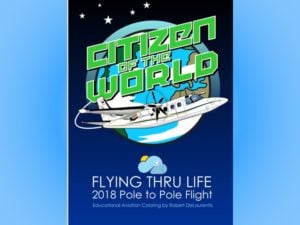 Robert DeLaurentis: And then, I don’t know if you know this, but we have a rough draft of our children’s nighttime book, called The Little Plane That Could. So we have the words and now it’s been sent to the illustrator, and our goal is to reach out and have a first exposure for very young kids, right. When they’re starting to dream about flying. And the aviation community is squarely focused on high school kids, because they’ll be pilots in a few years, but because we’re a 501(c)(3), we don’t have that limitation, and we wanna reach further back and grab their attention when they’re impressionable and when they’re dreaming.
Robert DeLaurentis: And then, I don’t know if you know this, but we have a rough draft of our children’s nighttime book, called The Little Plane That Could. So we have the words and now it’s been sent to the illustrator, and our goal is to reach out and have a first exposure for very young kids, right. When they’re starting to dream about flying. And the aviation community is squarely focused on high school kids, because they’ll be pilots in a few years, but because we’re a 501(c)(3), we don’t have that limitation, and we wanna reach further back and grab their attention when they’re impressionable and when they’re dreaming.
Paula Williams: Oh no kidding, that’s where it starts right.
Robert DeLaurentis: Yeah, right. Right before they go to sleep right. When they’re about to dream.
Paula Williams: Exactly. And you know one of the things that I really love is that you’ve created interactive products where people use them with each other, like the coloring books. We took one of these to a family party and had everybody coloring on the same page, literally on the same page, and talking about your trip. Which I think is a great way to get conversations started, and to spend time with each other on something positive, instead of standing around talking politics which is what everybody dreads this time of year right.
 Robert DeLaurentis: Yeah and you know the thing we found about the coloring book is people sort of drop their defenses when they’re looking at a coloring book and dealing with their kids, and something very positive like our mission of One Planet, One People, One Plane. So you’re appealing to them on a different level. I think the thing that most people do is they just sort of smile and get excited, like it takes em back to a very positive time in their lives, and then they … you know coloring is not just for kids anymore as you know, so I like to think there’s some big kids out there coloring as well.
Robert DeLaurentis: Yeah and you know the thing we found about the coloring book is people sort of drop their defenses when they’re looking at a coloring book and dealing with their kids, and something very positive like our mission of One Planet, One People, One Plane. So you’re appealing to them on a different level. I think the thing that most people do is they just sort of smile and get excited, like it takes em back to a very positive time in their lives, and then they … you know coloring is not just for kids anymore as you know, so I like to think there’s some big kids out there coloring as well.
Paula Williams: Yeah, you get grandma and grandpa pickin’ up the crayons, which is wonderful too, so.
Robert DeLaurentis: I haven’t seen any grandmas and grandpas doing it, but [inaudible 00:13:08] might.
Paula Williams: Right, oh that’s so much fun. And then the other products as well, such as the challenge coins, those are meant to be interactive, where someone literally pays it forward to the next pilot right?
Robert DeLaurentis: You know before I get on to that, that press release you did on the coloring book I think was fantastic, I’ve already sent it to the AOPA.
Paula Williams: Oh wonderful.
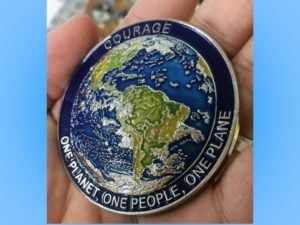 Robert DeLaurentis: If we can get them to bite. But, on to the coins, yeah the Challenge Coins are really I think pretty interesting, we have two of em right now there’s a world peace coin, and a courage coin. And the original intention with the courage coin was that pilots would buy it, and then give it to an aspiring pilot, and they would carry it in their pocket everywhere they went, and when they needed courage you know they could reach down and touch it, they could learn about the trip and have an example of someone who’s hopefully demonstrating those qualities. And then when they became a pilot they would fly it forward like you said Paula, to another aspiring pilot. So it would have this mission throughout the community, and be passed along and you know the people that would use it would see, “Oh this person had it before me, also was inspired and got their license. So if they can do it I can do it.” And then of course for collectors of the coins.
Robert DeLaurentis: If we can get them to bite. But, on to the coins, yeah the Challenge Coins are really I think pretty interesting, we have two of em right now there’s a world peace coin, and a courage coin. And the original intention with the courage coin was that pilots would buy it, and then give it to an aspiring pilot, and they would carry it in their pocket everywhere they went, and when they needed courage you know they could reach down and touch it, they could learn about the trip and have an example of someone who’s hopefully demonstrating those qualities. And then when they became a pilot they would fly it forward like you said Paula, to another aspiring pilot. So it would have this mission throughout the community, and be passed along and you know the people that would use it would see, “Oh this person had it before me, also was inspired and got their license. So if they can do it I can do it.” And then of course for collectors of the coins.
Robert DeLaurentis: And then from there when we started to focus on our world peace mission, it only seemed appropriate that we would have a world peace coin. And it’s just a reminder for people, every time I look at it I see world peace, and I see the planet, and I see the Citizen of the World. So it makes sense to me and one of the things we’re trying to do is take some of these coins with me. So each one of em is serialized whether it’s a coin on a key chain, hung from a string or a chain, or just simply carried in your pocket. So they’re serialized, they can be tracked, they’re one of a kind in that respect, and I just think the world needs a reminder. And if you think about world peace every time you reach into your pocket or look at your key chain, that’s part of manifesting it is bringing it into your conscious mind.
 Paula Williams: Right. That makes total sense. And then there’s also a very practical product, and you know a lot of people think socks are a terrible gift for Christmas, but you know what I love socks. I love getting socks, and compression socks are really important for pilots. I hear from a lot of women pilots actually on a lot of the boards, like the discussion boards and things like that, talking about the compression socks that they’ve tried, and how it makes so much of a difference as to not being exhausted at the end of the day and not having achy legs and everything else.
Paula Williams: Right. That makes total sense. And then there’s also a very practical product, and you know a lot of people think socks are a terrible gift for Christmas, but you know what I love socks. I love getting socks, and compression socks are really important for pilots. I hear from a lot of women pilots actually on a lot of the boards, like the discussion boards and things like that, talking about the compression socks that they’ve tried, and how it makes so much of a difference as to not being exhausted at the end of the day and not having achy legs and everything else.
Robert DeLaurentis: Do they lean over Paula and say, “You know I’ve got compression socks on right now?”
Paula Williams: Pretty much, yeah, women talk about that sort of thing amongst each other. But I don’t know if guys talk about that sort of thing but they should, so, there you go.
Robert DeLaurentis: Well, no the story behind the compression socks, I don’t know if you know this, is one of my good friends, a guy named John Kounis, who was doing a flight from Oakland to Brunei, in a Piper … or not a Piper, a Cessna 185. Couple weeks after the trip he died from a pulmonary embolism.
Paula Williams: A couple weeks after the flight?
Robert DeLaurentis: Yeah after his flight he got back to the US, he was supposed to meet me over in Greece, and they took him to the hospital and he died a short time later. And it was because that blood clot moved through his system. And we think that if he had been wearing compression socks it wouldn’t have happened. So that was a promise I made to his brother George, I said you know I want to do something positive to educate pilots, to make it safer, ’cause that’s one of our missions.
Robert DeLaurentis: And I was getting my haircut, and the lady who cuts my hair said, “You know I just got this new client, he has a compression sock business.” And I thought wow there’s a synchronicity, I can’t ignore that. Contacted him, we agreed to have him donate some so we could test the market, and now Aircraft Spruce just placed their second order. And they’re promoting it, and getting some pretty good response, so. That’s, it’s a small portion of what we’re trying to sell out there in the aviation community to fund scholarships and this trip, but it’s very positive. And as you probably know since you’re in this business, you never really know what’s gonna sell until you get it out there. And this seems to be one we’re getting traction with, no pun intended.
Paula Williams: Right. Yeah there are always surprises, we like to say that marketing is gambling with all of the data. You know statistically what’s likely to work, but then there’s always surprises out there.
Robert DeLaurentis: Yeah, yeah. Absolutely.
Paula Williams: Right. So you’ve been getting a lot of attention, I know in AOPA Magazine and the Smithsonian, do you wanna talk about some of, of how that’s come about?
Robert DeLaurentis: Yeah, you know AOPA the Aircraft Owners and Pilots Association has been with me since two thousand … I probably made contact with them in 2014, about a year before my trip, and they have been some of the strongest supporters that I’ve had. You know they’re passionate people, they’re pilots, they’re spending their time promoting aviation, and they’re dedicated. They have a wonderful organization that’s backed by some great philanthropists, and I’m friends with a lot of em. I like them. And they have backed me on this trip, they’re running videos on AOPA Live, Tom Haines and Warren Morningstar. Good friend Jiri is their VP of Marketing, we’ve traveled together but he is my strongest supporter. We’re set up to do some video blogs on the trip. I’m blogging for them with a reach of about 400 000 people.
Paula Williams: Oh that’s great.
Robert DeLaurentis: I have regular interaction with them. And then most importantly maybe, their 80th anniversary logo is on the nose of the Citizen of the World, and all the senior people have hand-signed that. So I’ll be taking their colors over Antarctica, during their 80th anniversary, which I’m very proud of. And then most recently I reached out to the Smithsonian, to one of their editors, and she sent me back a wonderful email yesterday talking about how they want to feature the flight. It’s her social media and they’ve asked … well she’s mentioned that there’s a possibility I could come lecture for them. And that for me would be just a dream come true. I mean this is the Smithsonian you know, it helps validate our causes, and the flight, and reminds me that I have a lot of supporters out there.
Paula Williams: Right, and you read your list of supporters it’s just like the who’s who of adventurers and explorers and companies that are doing cutting edge things, and things like that. I know the UN Association has asked you to speak at a couple of, actually many different places.
Robert DeLaurentis: Yeah, we are partnering with them. And it’s the San Diego regional office, but there are 250 offices all over the world. And they have this fantastic reach. It’s a grassroots organization that supports the UN, and I believe the UN Foundation which is … helps fund their efforts, is part of that. But talk about reaching out to the world [inaudible 00:20:31] a very positive cause. We support their 17 sustainability goals for 2030. They talk about the oceans, and education for all people, fresh water. And you know certainly the sky and the clouds and where I will touch with my plane are sort of covered as well. So yeah this is taking on a whole new life. We had dreamt the impossibly big dream, which is involvement from people and organizations like this, but it’s unfolding now, so. I’m excited to see what it’s gonna be like when the trip starts, ’cause people tend to be more engaged, and then of course we’ll leverage that for the two years after to see what we can do.
Paula Williams: Right, exactly. When you can refer them to things that are actually happening, and not just going to happen.
Robert DeLaurentis: Right.
Paula Williams: Yeah, the Explorers Club is another really big one that is really exciting as an opportunity as well right?
Robert DeLaurentis: Yeah, that’s unfolding right now, I was just accepted into the Explorers Club a few days ago.
Paula Williams: Congratulations, that’s wonderful.
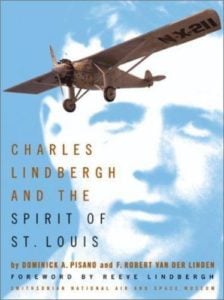 Robert DeLaurentis: This is a big deal, I didn’t realize how big it was actually, until after I got accepted, you know, I started to do a little more reading. And you know astronauts have carried their flag to the moon. They have had flags at the North and South Poles, I believe it’s in the Marianas Trench, the deepest part of the ocean. And I’m applying right now to carry one of their flags on the entire trip. And they started with 200 of these flags back in, I believe it’s 1902, and they retire … they’ve retired some of them, but I may be taking one of these original flags with me, with so much history. It’s absolutely awesome. And people like Neil Armstrong, Richard Branson, just an amazing list of explorers and philanthropists really.
Robert DeLaurentis: This is a big deal, I didn’t realize how big it was actually, until after I got accepted, you know, I started to do a little more reading. And you know astronauts have carried their flag to the moon. They have had flags at the North and South Poles, I believe it’s in the Marianas Trench, the deepest part of the ocean. And I’m applying right now to carry one of their flags on the entire trip. And they started with 200 of these flags back in, I believe it’s 1902, and they retire … they’ve retired some of them, but I may be taking one of these original flags with me, with so much history. It’s absolutely awesome. And people like Neil Armstrong, Richard Branson, just an amazing list of explorers and philanthropists really.
Paula Williams: Right. Exactly. So one thing we ask everyone who joins us on our podcast is what book or movie inspired you the most?
Robert DeLaurentis: Well one of my favorites, Charles Lindbergh’s The Spirit of St. Louis. Amazing book, one because I’m talking to his grandson Erik Lindbergh right now, but you know the things that he experienced on his flight across the North Atlantic, very similar to the things that pilots experience now on these long distance trips. Pilot fatigue, having an aircraft that’s functional but simple, and not too complicated is [inaudible 00:23:10]. He talks about how he dealt with the long periods of time. He did some hallucinating, I’m hoping not to have to go through that drill. But navigation, weather, and it’s like you sort of reach back in time to some of the greats, so really wonderful book. That has definitely inspired me.
John Williams: So, you’ve been flying quite a bit, what’s your favorite airplane?
Robert DeLaurentis: Well I would say my favorite airplane’s the one I’m flying, which is the [inaudible 00:23:42]. Yeah that’s actually very humble because most pilots always are looking ahead to the next plane, but I’m very very satisfied and happy with the [inaudible 00:23:51] Commander 900. It is the latest version which Gulfstream bought from Rockwell. And mine’s a 1983, so little bit of an older plane, but new Honeywell TPE-10T, 331-10T engines, MT-Propellors, a fantastic 52-foot wing, and all kinds of space inside the cabin of the plane, for six extra fuel tanks. New avionics panel by Avidyne, infrared sensor by [MacsBiz 00:24:23], I mean this … an environmental system by Peter Schiff, this is one amazing aircraft. And it has great ramp presence, which will help us during the flight and after, to help draw people into aviation. A very high flying plane, we modified it to fly at 35 000 feet, instead of 28. Very fast. We still don’t know how fast it’ll go ’cause we just put in this new environmental system that speeds it up a bit. But on my last flight at a lower altitude I got 302 knots which is around 350 miles an hour. And I know I can get faster than that.
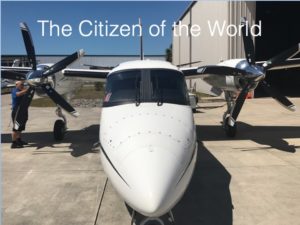
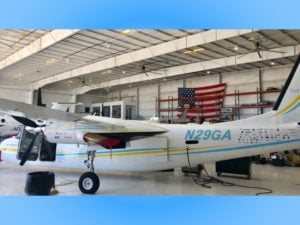
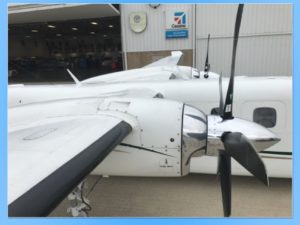
Robert DeLaurentis: And then the fantastic range. When it’s properly outfitted we think we’ll have a range somewhere between 5000 and 6000 nautical miles. So that’s like flying from San Diego to Honolulu and before you land you remember that you left your wallet on the counter back home, so you turn around and fly all the way back, and you still have fuel in your tank. So somewhere between 20 and 24 hours of flight time. And it’s funny because The Robb Report is doing a story that should air in December, and they’re calling it The Dream Machine. So a fantastic aircraft. Actually used by the Panamanian and Colombian militaries for counter drug ops. But more interesting is that the engines on that plane are the same ones that the Predator drones use. Which have just one of them, but they’re very very reliable aircraft. You know the US military could pick anything in the world, and they’d pick that engine.
Robert DeLaurentis: So yeah I feel fortunate to fly it. You know flying is such an incredible experience because you bring multiple things together all at once. You’re traveling the world, you’re connecting with nature, you’re flying the aircraft, and more than likely you’re with your friends. So put all those things into one moment in time, and that plane is just as good as it can get.
Paula Williams: Right, I think it was a trick question John to ask Robert what his favorite airplane was.
Robert DeLaurentis: I could go on for another hour.
John Williams: So after the trip … so what’s gonna happen to the airplane?
Robert DeLaurentis: Well I’ll take it for two years to use it to promote aviation and our world peace cause and the oceans, and any other cause we pick up along the way, because it is our global billboard. I hope to continue to fly it all over the world, ’cause it’s certainly capable of those distances and that mission. My goal is to let as many people see all those flags, and the sponsors, as humanly possible. And I think it’s hard to get in front of that plane with those huge props and the flags and all the colorful decals, and not get excited about aviation. I mean people just stand there and stare at it. Including me, and I’ve seen it a few times, so.
Paula Williams: Right, exactly.
Robert DeLaurentis: If the Smithsonian said they wanted to take it, maybe we’d figure out a way to do that, but.
Paula Williams: Oh maybe in 50 years or something, after you’re done with it.
Robert DeLaurentis: Yeah, still have a few things to do with it that’s exactly right.
Paula Williams: There you go. So how can people get involved with the trip, with the foundation, with you, what can they do to help with this?
Robert DeLaurentis: Well, they could go to www.poletopoleflight.com. Or they can go to the DeLaurentis Foundation, it’s delaurentisfoundation.org. That’s where if they wanna contribute in anyway possible they could look at some products, they could even donate some cash, which we always need. But to learn about the details of the flight, that poletopoleflight.com is a good way. And then of course we’re on most of the social media, so Facebook, Twitter, Pinterest, YouTube, Google Plus, Instagram. You type in Zen Pilot you’re gonna find us pretty quickly.
Paula Williams: Fantastic, yeah, and I know on that DeLaurentis Foundation if you want to know more about any of the products there are some fabulous articles out there that will tell you all about them right?
Robert DeLaurentis: Yeah I think you wrote some of em didn’t you?
Paula Williams: Exactly. That’s our contribution to the effort and we’re really excited to be working with you, and I’m glad we were able to find a way to make that work because I’m really excited about your mission as well.
Robert DeLaurentis: Yeah your contribution has been huge, at ABCI. I, you know we’re searching for as many ways to get the word out. You guys have certainly taken the products and run with them, and you know no one person like I said could do it, and we’ve handed off into your capable hands, so thank you. Appreciate that.
Looking for the perfect Christmas gifts? Here’s an idea from the DeLaurentis Foundation!
Podcast: Play in new window | Download
Subscribe: Spotify | Amazon Music | RSS




